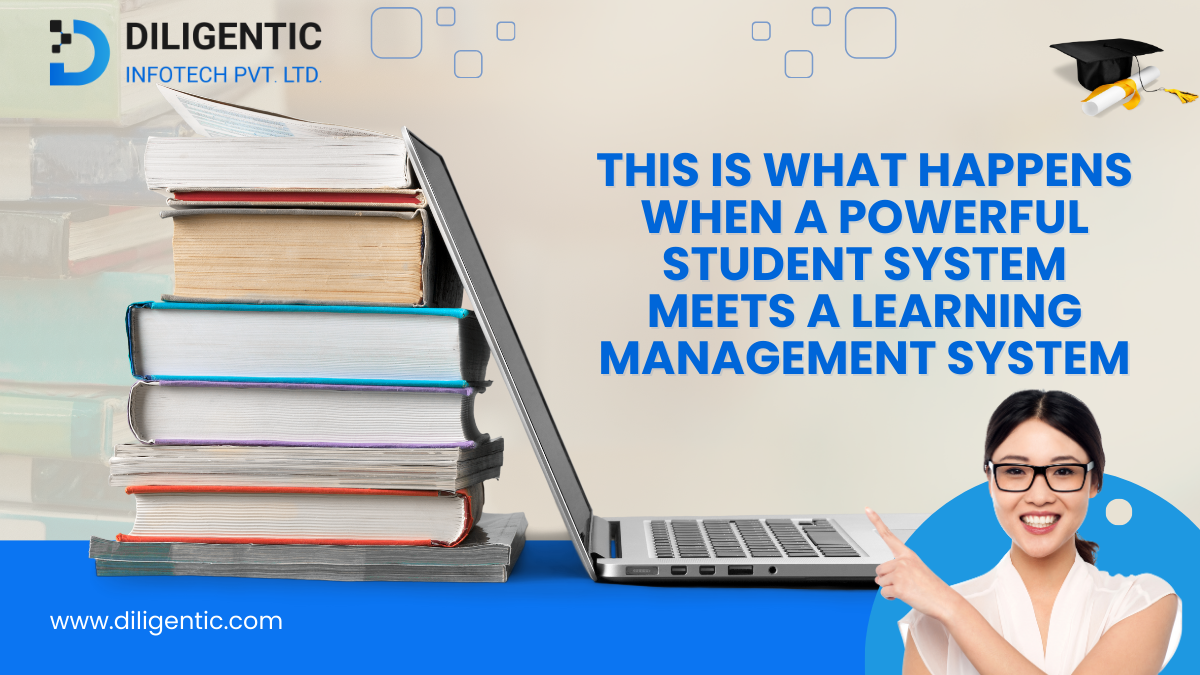SHARE

This Is What Happens When a Powerful Student System Meets a Learning Management System

What happens when an advanced student system integrates with an intelligent learning management system? The answer is a more connected, efficient, and personalized learning journey. Both systems benefit educational institutions, but integration changes the game.
Whether you’re overseeing a few hundred or several thousand students, integrating top-tier administrative and academic tools can greatly enhance efficiency and lead to better overall results. Let’s break it down clearly to see what this powerful pairing does.
Table of Contents
What is a Student System?

A student system, commonly known as a student information system, is the digital foundation of any academic institution. It handles everything related to student records and administrative tasks, including:
- Enrollment and registration
- Grades and academic history
- Attendance tracking
- Student financial information
- Timetables and course schedules
- Communication with students and parents
This system provides the back-end support needed for smooth school or college operations. But by itself, it doesn’t handle the actual delivery of learning materials or monitor real-time engagement.
What is a Learning Management System (LMS)?

An LMS, or LMS learning system, is focused on the academic side. It allows institutions to create, share, and track educational content. An LMS is where the teaching happens. Some of its common features include:
- Course and module creation
- Uploading videos, documents, and quizzes
- Tracking student progress
- Sending announcements
- Hosting discussions and forums
- Managing submissions and grading
The LMS helps teachers reach students in a flexible, digital way, whether through blended learning or fully online courses.
Why Integration Matters: SIS + LMS Together
Using a student information system and an LMS separately can cause friction. You may face duplicate data entry, performance tracking delays, or departmental confusion.
But when these systems are connected, the results speak for themselves. Integration removes separation between areas and makes everything from admission to graduation more efficient.
Key Benefits of Integration
1. One Platform, One Login
No more faking multiple usernames and dashboards. Students and staff get a single entry point to access grades, course materials, and schedules.
2. Real-Time Synchronization
Changes made in the student system are reflected immediately in the LMS and vice versa. For example, a student enrolling in a new course through the student information system automatically gets access to that course’s materials in the LMS.
3. Less Manual Work
Staff don’t need to manually copy data between platforms. Attendance, scores, and assignment updates flow freely and accurately between systems.
Looking for more ways to simplify operations? Check out our post on school management software.
4. Improved Reporting & Analytics
Schools and colleges get better data when both systems speak to each other. It becomes easy to see which students are struggling and what content is underperforming.
5. Better Student Experience
Students don’t have to contact multiple departments for different queries. Everything from course content to fee payments is visible in one place.
Common Use Case: How It Works in Action
Let’s say a college student registers for her semester online using the student system. Once approved, she’s automatically enrolled in four new courses.
- The student information system confirms her course selection and updates her academic record.
- The LMS learning system sends her login access and adds her to all relevant virtual classrooms.
- As the student completes weekly assignments, the LMS scores them and syncs them with the student system.
- Her advisor gets real-time performance updates pulled from both systems, allowing early intervention if needed.
This is not a future scenario; it’s what the best-integrated platforms are already doing.
How ERP Systems Fit In

An ERP system (Enterprise Resource Planning) acts as an umbrella platform that integrates student systems, LMS, HR, finance, and more.
Benefits of using an ERP include:
- Centralized data from all departments
- Real-time decision-making
- Stronger data security and compliance
- Unified dashboards for stakeholders
- Time and cost savings from reduced repeated work
While many institutions use an LMS or SIS separately, combining them under an ERP system takes efficiency to the next level.
Comparison Table: Student System vs LMS
| Feature | Student Information System (SIS) | Learning Management System (LMS) |
|---|---|---|
| Purpose | Admin & academic record keeping | Content delivery & student learning |
| Main Users | Admins, Registrars, Advisors | Teachers, Students |
| Functions | Enrollment, grades, schedules | Course access, assignments |
| Data Handling | Personal & academic records | Educational resources & tracking |
| Works Best When | Paired with LMS for full visibility | Paired with SIS for personalized content |
Why Schools and Colleges Are Making the Shift
Educational institutions worldwide are moving toward cloud-based platforms that integrate both systems. Here’s why:
- Students expect seamless, digital-first learning.
- Teachers want better ways to track progress.
- Administrators need more innovative data tools for reporting and funding compliance.
- Parents wish for transparency in performance and communication.
When your LMS and student system are integrated, you meet all these expectations in one place.
Features to Look For in an Integrated Solution
If you’re thinking of combining both systems, here’s what to look for:
- APIs or connectors for integration
- Role-based access for students, staff, and parents
- Mobile compatibility for real-time access
- Customizable dashboards for analytics
- Automated workflows (e.g., grading, reminders, approvals)
- Security compliance with FERPA, GDPR, or local education laws
Final Thoughts: Seamless Learning Starts with Seamless Systems
Bringing together a student information system with an LMS is no longer a luxury. It’s necessary for institutions that value efficiency, engagement, and academic success.
At Diligentic Infotech, we help schools, universities, and edtech startups build reliable, fully integrated systems that work. From design to deployment, we ensure your platform runs smoothly and better serves every user.
👉 Want to talk about building or integrating your student system and LMS? Let’s Talk
FAQs
What is a student system in education?
A student system is a platform that manages enrollment, grades, attendance, and academic records.
How does a learning management system help students?
An LMS delivers course content, tracks progress, and supports online learning activities.
What are the key benefits of using an ERP system in education?
An ERP system centralizes student data, course content, and admin functions into a single connected platform.
Why is a learning management systems important for online education?
Learning management systems enable digital classrooms with tools for assignments, grading, and collaboration.
Engage with our experts
Subscribe to our newsletter!
Be the first to get exclusive offers and the latest news.

